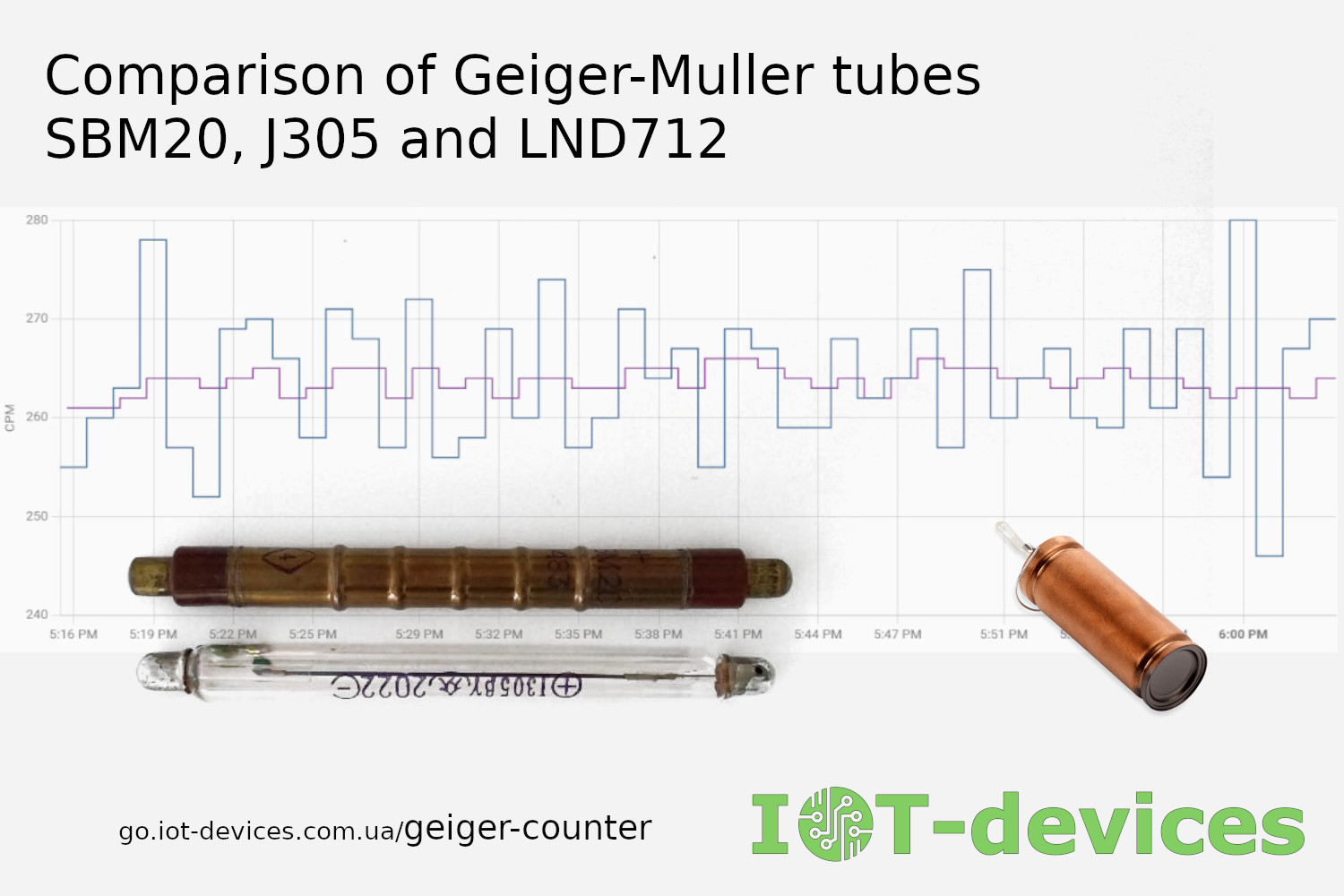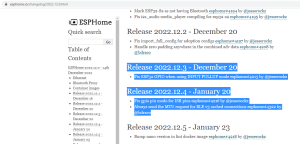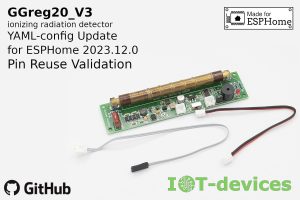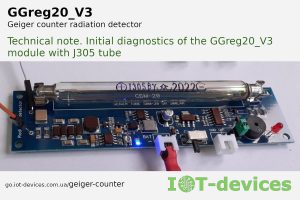We understand very well the difficulties of choosing for radio amateurs who have to choose between different options, including tubes, when ordering a product.

When we developed GGreg20 in 2020, we did not know anything about these things at all. Now we can share our company’s experience with anyone who needs help or is just looking for more information
Please note that we are mostly comparing the SBM20 і J305 Geiger-Muller tubes, that the GGreg20_V3 comes with, and the LND712 tube is mentioned here as another alternative to both tubes. This allows us to extend the comparison to the capabilities of the more complex and expensive LND712 tube. Without such comparisons, this publication would have no depth and would be reduced to the thesis that SBM20 and J305 are interchangeable and therefore there is nothing to compare them.
Here are the key points to consider when choosing a Geiger-Muller tube for a DIY project:
- The purpose of the DIY project;
- Types of radiation that the tube can detect;
- Sensitivity of the tube;
- Internal noise and insensitivity;
- Operating voltage level;
- Dimensions and method of mounting the tube;
- Country of origin and year of manufacture.
Let’s consider and compare the tubes from these angles in more detail.
The purpose of the DIY project
The way you set the project goal may determine what success criteria you will use to measure the results you have or have not achieved.
With the Geiger counter, the project goal can also be very different.
For example:
- a cheap stationary device that should measure background radiation and alert you to danger most of the time;
- a miniature pocket device as a personal safety sensor for hiking;
- a sensitive and high-speed meter for detecting radiation in food and other materials;
- a meter/signalizer for radioactive gases in the air, such as household radon.
The task for which the end device is being developed may require the selection of a tube in terms of size and not require high sensitivity at all, etc. Therefore, only the user can determine for himself which tube in the Geiger counter is suitable. We can only point out that the selection of a tube according to the project task is a complex multifactorial analytical process, which we have tried to describe in depth in this publication.
Types of radiation
It is quite simple: you need to choose a tube depending on what radiation you need to measure in your project.
Most common tubes are sensitive to gamma and beta radiation. Some tubes are also capable of measuring the alpha channel.
Please note that the alpha channel in tubes is usually realized by having a mica window in the end of the housing.
To convert an a,b,g-tube to a b,g- tube, it is enough to close the mica window tightly with a piece of paper or the plastic cover of the housing.
To turn a b,g- or a,b,g- tube into a g- tube only, you need to shield the tube from beta particles. This can be accomplished by an aluminum casing with a thickness of several millimeters. Such an aluminum casing shields the tube from both beta and alpha particles at the same time.
As far as this article is concerned, the SBM20 and J305 tubes are capable of measuring beta and gamma radiation. The LND712 tube has all three channels: alpha, beta, and gamma.
How can this affect a DIY project from a practical point of view?
If you plan to measure only gamma rays with the SBM20 / J305 tube, then you need to shield such a tube from beta particles.
If you need to measure only beta particles with the SBM20/J305 tube, then you can try to use two such tubes at the same time: one with a shield that protects against beta particles, and the other without such a shield. In this case, by finding the difference between the measurement results for each tube, we can calculate the quantitative characteristic for beta particles.
The same applies to alpha particles: by filtering the alpha channel and subtracting the results between the tubes, we find the quantity for alpha particles.
With the LND712 tube, which is sensitive to a,b,g-, it is possible to implement a project to measure household radon, in particular Radon-222, since this isotope is the source of alpha particles.
It should be emphasized that for measurements with several tubes, you need to have several GGreg20_V3 modules. Each module is connected to a separate GPIO of the main controller, which in turn will be able to count pulses independently for each tube.
Tube sensitivity
When we first started to figure out which tubes to use for our GGreg20 Geiger counter project a few years ago, we experimented and sometimes mistakenly chose tubes that were capable of producing only a few pulses per hour at background radiation levels.
Of course, they would be impossible to use in a DIY Geiger counter project, which should be sensitive enough to measure background radiation most of the time.
| The sensitivity of the tube is important Depending on the objective of your project, you need to choose a tube with the appropriate sensitivity. |
So, when you are choosing which of the GGreg20_V3 options to order, don’t worry and know that we have already tested different tube models for you and have included in the options only those that really work with the GGreg20_V3.
J305 and SBM20 tubes, although they have some differences, work equally well with our product.
The LND712 tube, although not currently available as an option for the GGreg20_V3, also works very well with our Geiger counter module..
In general, the LND712 has a lot of interesting functions and features that can make a project with the GGreg20_V3 module even more interesting. Perhaps in the future we will offer this tube as an additional option as part of the Geiger counter module of our production.
In terms of sensitivity (pulses/mR), the LND712 tube is not much different from the SBM20, but given that it is more modern, we would prefer it
Own noise and insensitivity
Geiger tubes have two important characteristics that should be taken into account when comparing them.
Internal noise is the false-positive pulses generated by the tube in the absence of external radiation. When designing or calibrating a tube, the manufacturer places the test sample in a radiation-shielded laboratory environment and measures the number of false-positive pulses per unit time. Typically, the intrinsic noise of the tube is specified in the datasheet in pulses per second.
The SBM20 tube, compared to the J305 and LND712, has a significantly higher intrinsic noise value according to the datasheet. This means that the SBM20 tube will measure natural background radiation much worse than the J305 or LND712 tubes.
Insensitivity is the time during which the tube recovers from the previous avalanche-like disturbance and is unable to detect the next such event. This time is commonly referred to as the dead time of the tube and is measured in microseconds. In practice, as a consequence, the tube is not able to generate an output pulse during this period of time.
It is also worth noting that the dead time directly depends on the size of the tube. The longer the tube is, the longer this time is. Of course, the length is not the cause, but only a consequence of the general design of most tubes and their principle of operation.
If your project is aimed at measuring high levels of radiation, this property of the tube must be carefully considered, because the higher the radiation we measure, the more dense the events that the tube records will be. At a certain point, the limit will be reached beyond which insensitivity will begin, i.e., the density of events in time when the tube simply does not have time to recover to register them.
Due to its size, the LND712 tube (90 microseconds) is the leader in this indicator, which is half that of the SBM20 and J305 tubes (190 and 180 microseconds).
Note. Here we present the Dead Time for J305 based on the data from the Internet, since the datasheets from suppliers do not contain this data.
Sensitivity to UV. It is worth mentioning the sensitivity of glass-bodied tubes (such as J305) to the rays of ordinary sunlight, especially to the UV spectrum. Indeed, you can find videos of experiments with a UV flashlight and ordinary sunlight on the Internet. The tubes in those videos are just going crazy from these stimuli, which can be seen with the naked eye.
We also conducted a quick test. We were unable to reproduce the behavior of J305 shown in the video. It is possible that the tube that generates false-positive events in the video from the Internet has some physical or technological defects that cannot be identified without special equipment.
We sympathize with the owner of such a tube. And because of this, we decided to test random samples from a batch of our J305 tubes, which are supplied as an option to the GGreg20_V3 module. Although our J305 tubes did not show such an effect, we fully agree that sunlight can create additional noise in measurements. We recommend placing the J305 tubes in a light-tight enclosure if possible.
With the Geiger counter module GGreg20_V3, we offer (as an option) a protective cover printed on a 3D printer. Although this cover is not able to act as a full-fledged shield for the high-energy photon flux of sunlight, it will at least partially filter one of the sources of possible noise.
The level of operating voltage
When comparing the available tube options, keep in mind that different types of tubes may have individual supply voltage levels. This information is usually included in the datasheet for the tube.
In practice, it is also important to keep in mind that the Geiger counter module (and its settings!) on which the tube you choose will be installed is crucial.
The GGreg20_V3 module was designed to be able to provide the widest possible range of operating voltages. On the one hand, the GGreg20 supports 200 – 1200 V in the high-voltage part. On the other hand, the module can be powered in the range of 2.4 – 5.5 V. As far as we know, this is the widest range of supply voltage among similar modules.
Therefore, in terms of high-voltage supply voltage, the GGreg20_V3 module supports all the tubes we are reviewing and comparing: J305 (380V for the model with a glass tube), SBM20 (400V), LND712 (500V).
In practice, beyond the scope of this material, we advise you to always pay attention to whether the module that will work with the tube allows you to adjust the voltage required for the tube to work. Exceeding the supply voltage of the tube is guaranteed to damage it. If the voltage is too low, the tube will simply not work.
Dimensions and method of mounting the tube
The J305 and SBM20 tubes have similar dimensions and a convenient mounting method that does not require soldering. From the point of view of manufacturing microelectronics for IoT devices, they are medium in size compared to other Geiger tubes.
SBM20 and J305 can be called interchangeable, because they have a similar operating voltage level, the same terminals, and almost the same dimensions, which allows you to replace the tubes with each other if necessary, if you can set the appropriate conversion factors for CPM.
It is particularly convenient that on the board of a Geiger counter module such as the GGreg20_V3, the mounting supports both tubes. It is also useful that the Geiger tube can be quickly removed from the module or replaced. In the case of the SBM20/J305, this is as easy as changing the batteries in a flashlight.
The LND712 has about half the length, which makes it ideal for the size of the a,b,g-radiation sensor. But its output pins are made in such a way that it only needs to be soldered. Therefore, LND712, paired with a much higher price, is no longer as “convenient” as SBM20 or J0305.
Sometimes, in order to adjust the settings of the Geiger counter module, you need to be able to remove the tube – in the case of LND712, this will be impossible without soldering.
It’s also worth noting that in the case of building pocket devices, the length of the tube can be crucial. Let’s see: the thickness of the device will also be affected by the battery, buttons, and connectors, so the diameter of the Geiger tube is leveled by these other limitations and does not affect the dimensions of the device body. However, the length of the tube requires an increase in the size of the device body. For these reasons, the LND712 tube is significantly better than the SBM20/J305.
Country of origin and year of manufacture
In our opinion, the country of origin is no less important than the other characteristics of the tube. Even from a purely practical point of view (cost and time spent on logistics, supporting local businesses, paying taxes, etc.), it is better to buy a tube that is made in the United States.
Unfortunately, we are not aware of any opportunities to purchase tubes made in Ukraine. Our quick searches for Ukrainian tubes did not turn up anything..
If you know of any Ukrainian-made Geiger-Muller tubes, please contact us
The stocks of Soviet SBM20 tubes at private sellers are significantly depleted. The shelf life of the Soviet models has long since expired. That is why we are constantly looking for alternatives. One such alternative is the Chinese-made J305 tube. The J305 tubes sold on Alibaba and Aliexpress are of 2020-2022 production year and fully meet our requirements in terms of technical characteristics and quality.
LND712 tubes also have excellent specifications, quality, and functions. The only drawback is that they need to be purchased in the United States, with long logistics to Europe. Given the higher relative cost of these tubes and the lack of an organized official retail distribution network for LND712, it is clear why this tube has not been in the lead in the statistics of DIY Geiger counter projects.
Conclusions
We’ve been monitoring our own statistics for several years now, as well as those of projects like radmon.org, ThingSpeak, uRADMonitor, and others.
The Soviet-made SBM20 tube is probably the most popular among those used in DIY projects.
However, it is almost impossible to buy SBM20 anymore, as Soviet-era stocks are depleting, the shelf life and expiration date have expired, and the manufacturers of modern SBM20 tubes are only in a country that is under sanctions and is an internationally recognized aggressor, a sponsor of terrorism and is currently committing war crimes and crimes against humanity at least in Ukraine.
At the same time, the Chinese J305 is much easier to find and buy online, but only when it comes to the glass-body version. Unfortunately, J305 with a metal body is currently very difficult to buy for reasons unknown to us.
Unlike the SBM20 and J305, the American LND712 tube, in addition to beta and gamma, also has an alpha radiation measurement channel, which significantly expands its range of application in DIY projects. The LND712 tube has a metal body, like the SBM20, and a mica window for detecting alpha particles.
On Internet forums, users have suggested that the glass body of the J305 is not protected from photons of normal sunlight, which can interfere with the measurement process if the tube is not additionally protected by a sunproof cover.
We are not sure of this statement, although there is also some understanding on our part that glass tubes require a sunproof cover as glass can transmit light, including noise, which can increase the noise level of observations.
Conversely, the metal housing of the SBM20 and LND712 tubes can act as a shield to a small extent for electromagnetic interference and sunlight. This makes the measurement performance of metal tubes more stable. On the other hand, a tube with a glass body may be more sensitive to radiation, which is also a useful property under certain conditions.
But it should be noted that all of these are just assumptions that should be tested. However, we are not able to test all of this, because such tests require a specially equipped laboratory.
Besides, we always have a much better tool – the manufacturer’s datasheet. The tube must meet the characteristics and operate in the manner specified in the datasheet.
| Property | SBM20 | J305 | LND712 |
| Radiation type | beta, gamma | beta, gamma | alfa, beta, gamma |
| Dimensions (max), mm | d11 x 109 | d11 x 107 | d15.1 x 49.2 |
| Country of Origin | ussr or russia | China | USA |
| Vendor’s calibration radioactive source | Cs-137 | Co-60 | Co-60 |
| Sensitivity | 60 – 70 counts / uR at 4 uR/s Cs-137 or 240-280 CPS at 4 | 44 CPS at 1 mR/h Co-60 | 18 CPS at 1 mR/h |
| Dead Time | 190 us | No data | 90 us |
| At the background level | 60 pulses/minute | 25 pulses/minute | No data |
| Internal background noise | 1 pulses/s or 60 pulses/minute | 0,2 pulses/s or 12 pulses/minute | 0.17 pulses/s or 10 pulses/minute |
| Recommended operating supply voltage | 400 V | glass tube 380 V metal tube 400 V | 500 V |
If we were choosing a tube for ourselves, we would not hesitate to choose the LND712. However, since GGreg20_V3 does not currently support this tube size, we would choose between SBM20 and J305 as follows:
- Shelf life – J305 is better;
- Internal noise – J305 is better;
- Sensitivity – J305 is better;
- Country of origin – J305 is better;
- Background radiation – J305 is better;
- Calibration source – J305 is better (most tubes are calibrated by Co-60);
- Dead time – no difference;
- Metal case – SBM20 is better;
- Dimensions and mounting – no difference;
- Supply voltage – no difference;
- Retail distribution network – J305 is better;
- Price and quality – J305 is better.
Guided by the data from the documentation, statistics from the Internet and our own experience, we would definitely choose the J305. We would choose SBM20 only in exceptional circumstances, when for some significant reason J305 would be impossible to use.
Thank you for your attention!
Team IoT-devices, LLC
Additional resources on the topic:
https://iot-devices.com.ua/en/ggreg20v3-geiger-tube-j305/
https://iot-devices.com.ua/en/technical_note_supply_voltage_range_geiger_counter_ggreg20_v3/
https://iot-devices.com.ua/en/uv-test-of-the-j305-geiger-tubes/
https://iot-devices.com.ua/en/technical_note_performance_of_diy_geiger_counter_ggreg20_v3_at_low_-temperatures/
https://iot-devices.com.ua/en/geiger-counter-emulator-ggreg20_v3-module-by-means-of-esp8266-part1/
https://iot-devices.com.ua/en/maximum-radiation-that-can-be-measured-by-geiger-counter-ggreg20_v3-en/
https://iot-devices.com.ua/en/ggreg20v3-case-3d-model-for-personal-use/
Easy Links:
go.iot-devices.com.ua
/geiger-counter
/high-voltage-converter
/geiger-counter-emulator
/tindie


